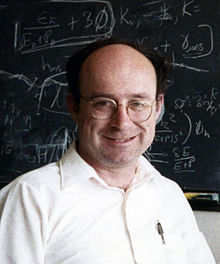James M. Bardeen
This biography of a living person needs additional citations for verification. (March 2013) |

James Maxwell Bardeen (born May 9, 1939) is an American physicist, well known for his work in general relativity, particularly his role in formulating the laws of black hole mechanics. He also discovered the Bardeen vacuum, an exact solution of the Einstein field equation.
Bardeen graduated from Harvard in 1960 and earned his doctorate at Caltech under the direction of Richard Feynman.[1] He is a professor emeritus of physics at the University of Washington in Seattle, and a Distinguished Visiting Research Fellow[2] at Perimeter Institute for Theoretical Physics. In 2012 he was elected to the U.S. National Academy of Sciences.[3]
Bardeen is the son of two-time Nobel Laureate John Bardeen.[4] His brother, William A. Bardeen, is also a physicist, and his late sister Elizabeth was married to Thomas Greytak, a physicist at MIT. In a 2020 interview given to Federal University of Pará in Brazil, Bardeen recalls his journey as a physicist, the influences of his father on him, his experiences as a doctoral student of Richard Feynman and working with Stephen Hawking.[5] [6] [7]
See also[]
- Bardeen-Petterson effect
- Cosmological perturbation theory
- Post-Newtonian expansion
Notes[]
- ^ Bardeen, James Maxwell - CaltechTHESIS
- ^ "James Bardeen". Perimeter Institute for Theoretical Physics. Perimeter Institute for Theoretical Physics. Retrieved 12 January 2016.
- ^ James Bardeen, Array of Contemporary American Physicists Archived 2014-08-08 at the Wayback Machine
- ^ Hoddeson, Lillian; Daitch, Vicki (2002). True genius: the life and science of John Bardeen : the only winner of two Nobel Prizes in physics. Joseph Henry Press. p. 93. ISBN 978-0-309-08408-6.
- ^ Interview with Prof. James Bardeen - Part I. Federal University of Pará. 2020. Archived from the original on 2021-12-21.
- ^ Interview with Prof. James Bardeen - Part II. Federal University of Pará. 2020. Archived from the original on 2021-12-21.
- ^ Interview with Prof. James Bardeen - Part III. Federal University of Pará. 2020. Archived from the original on 2021-12-21.
External links[]
- James Bardeen, Perimeter Institute homepage
- Publications of James Maxwell Bardeen in the database SPIRES
- arXiv.org preprints for J. Bardeen
- search on author James Bardeen from Google Scholar
- 1939 births
- 21st-century American physicists
- Harvard University alumni
- California Institute of Technology alumni
- University of Washington faculty
- American relativity theorists
- Living people
- Members of the United States National Academy of Sciences
- Sloan Research Fellows
- American physicist stubs
